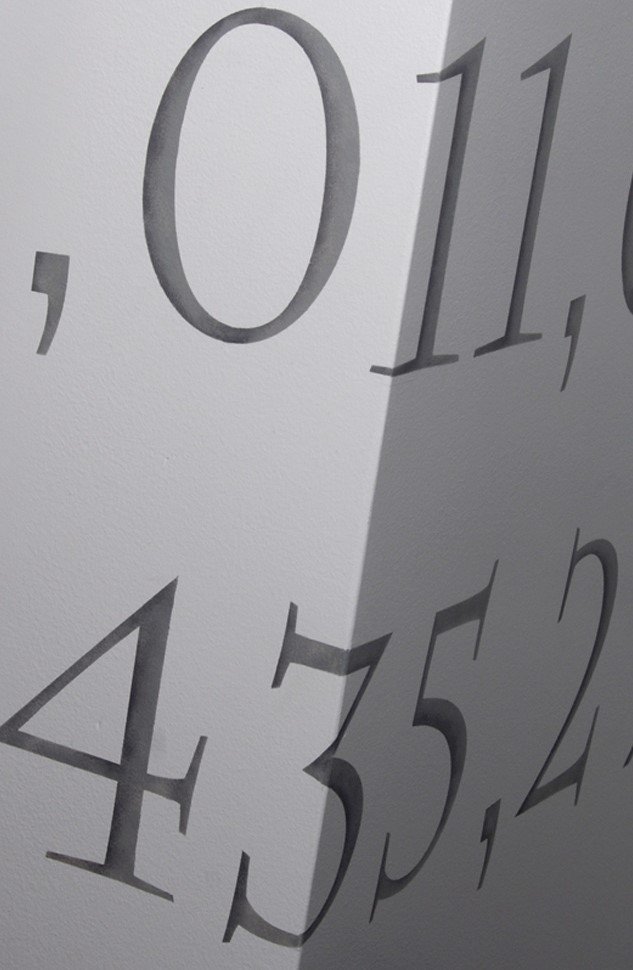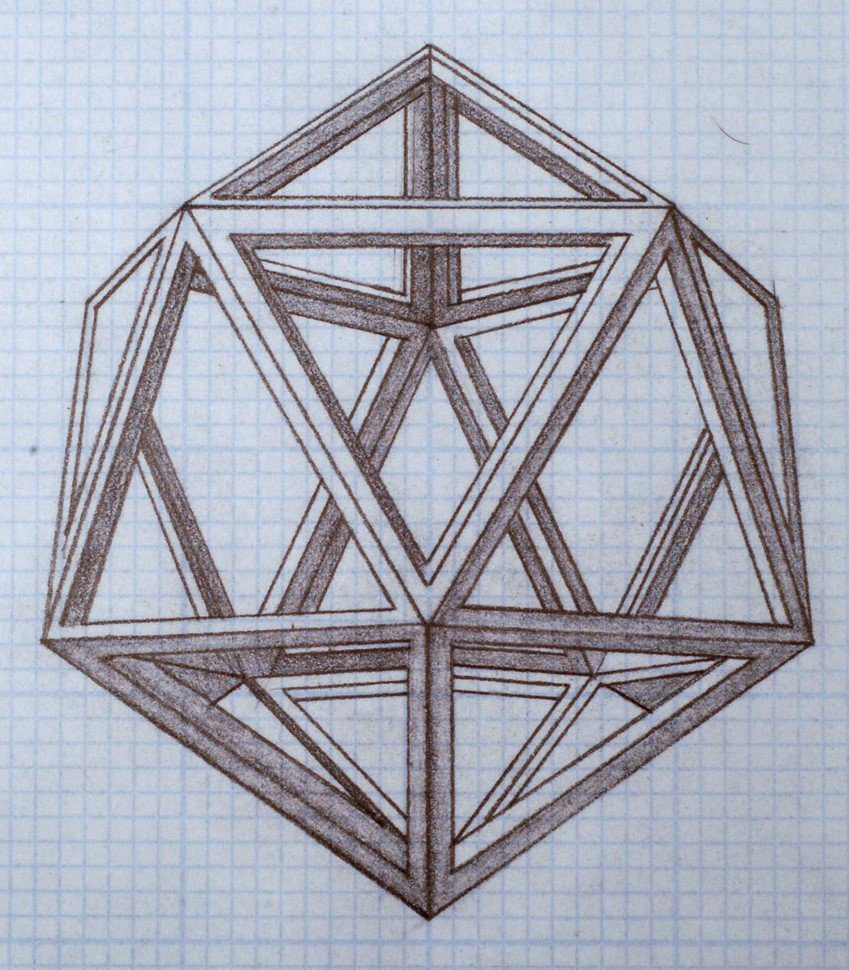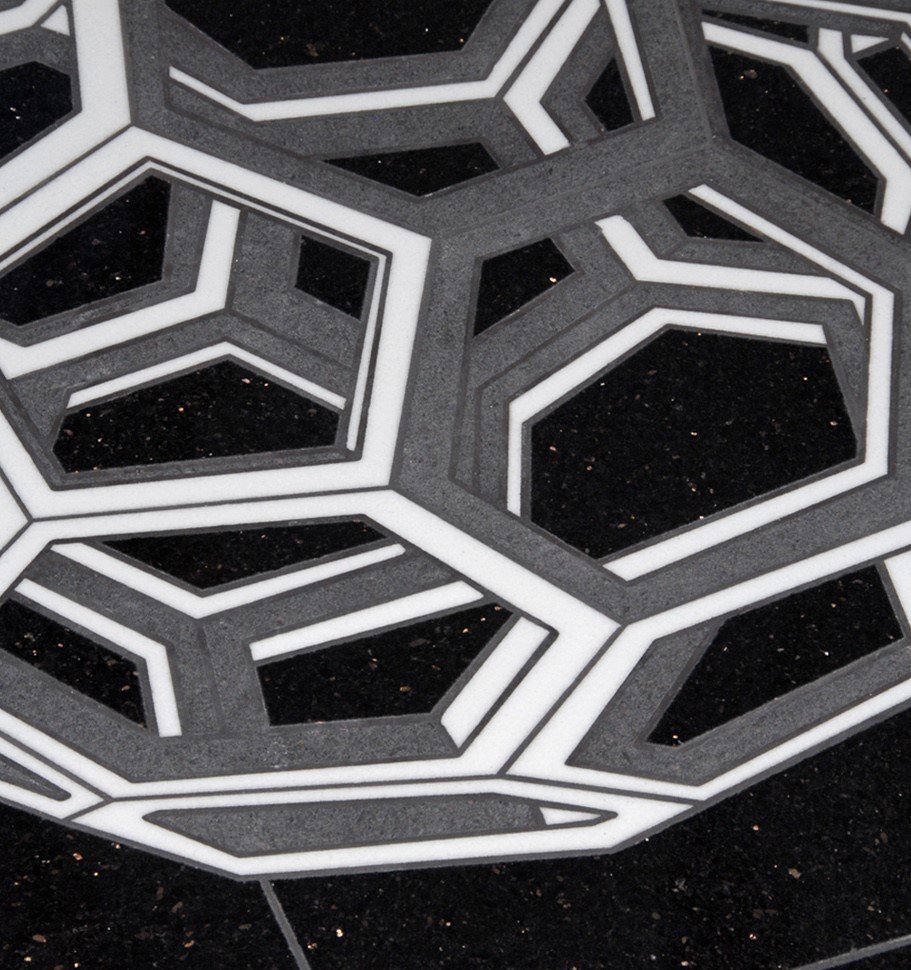LEONARDO DIALOGO
Center for Advanced Biomedical Imaging Research (CABIR)
The University of Texas Health Science Center
MD Anderson Cancer Center
Houston, Texas
2010
Glass Ceiling in collaboration with Martin Demaine & Erik Demaine
MIT, Cambridge, Massachusetts
-
seeking a conversation with art and science. What I found was a poem danced in synchronous languages.
The installation Leonardo Dialogo is the synthesis of a two-year artist-in-residency in Dr. Mauro Ferrari's nanomedicine research laboratory. It was a journey of interfacing with scientists whose passion paralleled the artist's but with fundamentally different ways of looking and communicating, to discovering and practicing the collaborative dance with two artist/mathematicians at MIT, and learning and working alongside the artisan fabricators whose expertise and pride in their work was essential in making the concept a reality.
As a site-specific art installation, the floor, ceiling, walls and doorways of the entryway corridor were visually and conceptually addressed. When the door is opened, the viewer encounters a hypnotically unique space. The floor, an inlaid granite canvas of intertwining complex polyhedra, combines the five geometrically "perfect" platonic solids with carbon 60 or fullerene. The carbon 60 molecule, its shape a truncated icosahedron, was discovered by Nobel Laureates Richard Smalley, Robert Curl and Harold Kroto in 1985, and became the building block of nanotechnology.
Math was discovered by the artist to be a beautiful visual as well as universal language understood by the globally diverse community of researchers. Scientists search for patterns in biological chaos to develop means to bring back a sense of balance and harmony to the human body. The math serves as a language for discovering methods and experiments. It explains events in nature and nature explains the math. Geometry exists in the organic and inorganic shapes in nature, as well as technology and engineering. On the entryway floor, the polyhedra twist in a galactic space of questions and possibilities.
As the viewer gazes from the floor to the ceiling, a reflection of the polyhedra infinitely spiral in the mathematical ratio of the golden mean. The artist, influenced by the construction of Fan Vaulting indigenous to the Gothic cathedrals of England, provided a contemporary approach to inspire a feeling of awe and wonder by covering the ceiling in mirror.
The doors were veneered with yew wood, an ancient tree species filled with myth and metaphor. Bringing organic warmth to the space in color and material, the artist's research revealed that from the bark of the yew tree, scientists successfully extracted the compound "Taxol". Used as a chemotherapy drug for treatment of breast, ovarian, lung and several other cancers, the yew became a powerful symbol of the research being conducted.
To complete the corridor, the walls were stenciled with three quotes (which are elaborated on below) and the Fibonacci sequence. Very simply put, the Fibonacci sequence is an infinite mathematical sequence of numbers starting with 0 or 1 where each subsequent number is the sum of the preceding two. The ratio of successive pairs of numbers expresses the "perfect" universal ratio of balance and harmony.
As one exits the entryway corridor and enters the administrative waiting area, the viewer's eye focuses on a "floating" glass ceiling of hand blown glass, integrating cutouts of the polyhedral shapes, through which directed LED lights cast shadows onto the floor and walls. The labyrinthine pattern of spiraling polyhedra symbolizes the researchers' journey to find answers and ask new questions, and the patient's journey to healing.
The concept of the glass component, and the combination of Math, Science and Art took the artist to MIT in Boston, where she collaborated with two artist/mathematician/hot glass experts: Martin Demaine, an artist-in-residence and visiting scientist in computer science, and Erik Demaine, Associate Professor in Computer Science. Their artistic work includes curved folded paper sculptures that are part of the permanent collection of the Museum of Modern Art (MOMA), in New York.
Leonardo Dialogo is an embodiment of a long lost partnership between art and science, where the two were essentially interconnected, and reciprocally necessary to advance each other. It offers an aesthetic and poetic interpretation of art and science's momentous journey to discovery, and mission of healing.
-Jo Ann Fleischhauer 2010
-
Service first! Et quasi nanos, gigantium humeris insidentes, ut possimus plura eis et remotiora videre
Service to all that suffer is the first tenet of all medical professionals, in the lab and clinic alike. The imagery of scientists as "little people on the shoulders of giants" is often, but incorrectly referred to Isaac Newton. It actually states as follows: Dicebat Bernardus Carnotensis nos esse quasi nanos, gigantium humeris insidentes, ut possimus plura eis et remotiora videre, non utique proprii visus acumine, aut eminentia corporis, sed quia in altum subvenimur et extollimur magnitudine gigantea (John of Salisbury, 1159)... hardly the origin of "nanos", but certainly harmonious with the view that nanotechnology, in close collaboration with the clinical and biological sciences, can remotiora videre and help provide decisive progress towards the solution of currently unsolved medical tragedies.
√ √ √ √ √ √-
Multi-rescaling the medical poetry of normal subgroups
Science and art drink of the same well - poetry in expression is clarity in image is focus on pursuit - is cure in the making. Symmetries yield the laws of the universe, inner and out there. Mathematics is the notorious language in which said laws are written - alas we humans see scales, one is already great, several are a great rarity, multi a great desire, toti the great objective.
A little quasi-exameter reminds us of Lucretius, who first sang of the discrete nature of matter per Democritus and Leucippus, but with the incessant process and architecture of metric poetry - a hopeful quasi-positivistic reminder of faith in the incessant progress of science. And, yes, the smallest group in which non-trivial normal subgroups can be found is the symmetries of the icosahedron - the veritable starting point of nanotechnology per the discovery of the fullerene, here across the street. The metaphor is that nano is the smallest, large enough to contain the treasure.
Fullerenes are incompatible with the translational symmetries that are required for generating large crystals - they are bound to be nanos. This very feature rendered them 'invisible' not only to the eye, but to the mind of scientists until Smalley, Curl, Kroto, and Heath. Reflections on translations - on three fronts: The materials symmetry groups and lattice symmetries of crystallography, with the rebellion by the fullerenes that dared exist; the hint at the fact that symmetries encode the laws of the universe; and the obvious cognitive metaphor. For the 0 and 1 we may have to ask Zeigarnik or utter "Rosebud", with existential irony!
- Mauro Ferrari 2010
PHOTOS BY KEN FREDERICK & JIMMY HEMPHILL












